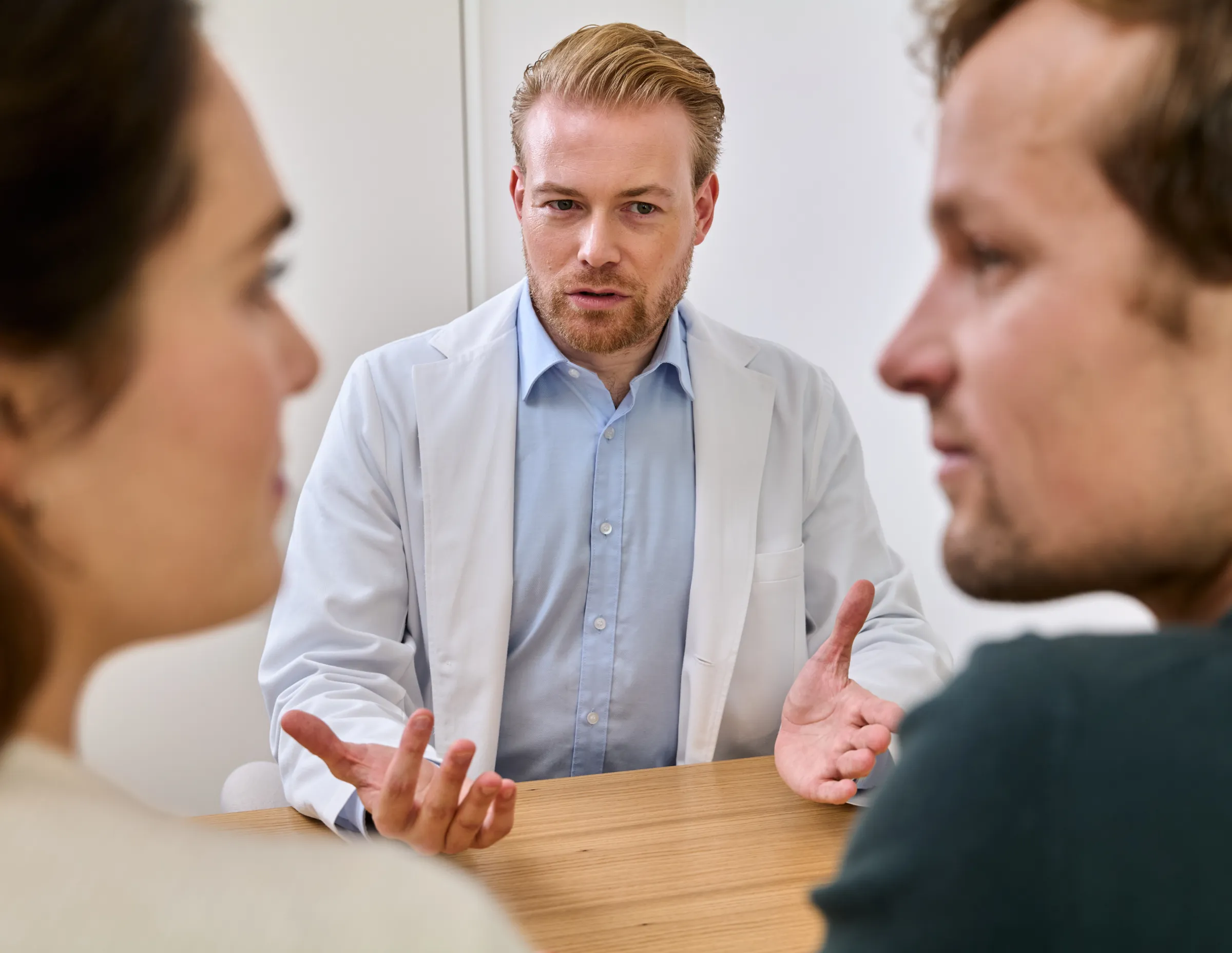Which hormones are involved in female fertility? This article gives an overview of the female sex hormones, also known as sex steroids, and their role in various aspects of female sexual development, fertility, reproduction, and overall health.
Which hormones are involved in female fertility? This article gives an overview of the female sex hormones, also known as sex steroids, and their role in various aspects of female sexual development, fertility, reproduction, and overall health.
What are reproductive hormones?
Hormones—chemical messengers released from the endocrine glands into the bloodstream—play critical roles in many bodily processes. In this article, we focus on a group of hormones known as sex hormones or reproductive hormones, which are produced in both men and women, mainly by the pituitary gland and by the gonads, which are the testes in the male and the ovaries in the female. These hormones help to promote and regulate fertility. In particular, we focus here on the hormones involved in female fertility, in its different phases from puberty to menopause. Let’s start with an overview.
Which hormones are important for female reproduction and fertility?
In the years between a woman’s first menstrual period, or menarche, and menopause (when menstrual periods have stopped for 12 consecutive months), a number of hormones play critical roles in female sexual function, fertility, and overall health. These hormones are mainly produced by the pituitary gland and the ovaries.
The pituitary gland hormones involved in reproductive functions include:
- Follicle-stimulating hormone (FSH). This hormone stimulates release of estrogen by the ovaries, and causes eggs to mature within the follicles (fluid-containing sacs) inside the ovaries during the menstrual cycle.
- Luteinising hormone (LH). This hormone triggers the release of mature eggs (ova) from the ovaries, in the process of ovulation.
- Human chorionic gonadotropin (HcG). Most prominent during pregnancy, this hormone helps to stimulate production of progesterone by the corpus luteum.
- Prolactin. This hormone is important for lactation, or production of milk and breastfeeding.
The three main reproductive hormones produced by the ovaries are:
Estradiol (a form of estrogen produced by the ovaries). Some of its functions include:
- Promoting breast development
- Helping to stimulate the growth of an egg follicle
- Helping to build and maintain the lining of the uterus
- Helping to maintain pregnancy
Progesterone. Its reproductive actions include:
- Helping to prepare the endometrium for implantation of a fertilised egg
- Helping to maintain pregnancy
Testosterone. Although often considered a ‘male’ hormone, females also produce testosterone, albeit in lesser amounts than males do. In women, testosterone is related to:
- Bone health
- Muscle mass
- Sex drive
Fluctuations in the above hormones can occur due to different factors, including:
- A woman’s age
- Phases of the menstrual cycle
- Pregnancy
- Menopause
- Stress
- Medications
- Environment
This article will take you through the involvement of these female sex hormones in different life stages and functions, including puberty, menstruation, sexual arousal and sex drive, pregnancy, and menopause.
Puberty
This period of maturation and sexual development of the female body, including the breasts, ovaries, uterus and vagina, usually begins between 8 and 13 years of age in females. Puberty is triggered by rising levels of LH and FSH. These pituitary hormones stimulate the production of the sex hormones, especially estrogen and progesterone. Increased levels of these sex hormones lead to the development of sexual secondary characteristics, which are features specific to each of the sexes that develop during puberty, but that are not directly involved in reproduction. In females, these include:
- Breast development or budding
- Pubic and axillary (armpit) hair growth
- Increased height (growth spurt)
- Increased body fat
- Widening of pelvis and hips
- Acne
These changes typically precede menarche, or the first menstrual period.
Menarche and the menstrual cycle
In the course of puberty, the first menstruation takes place. Menstruation refers to the bleeding that occurs when the lining of the uterus is shed through the vagina. The menstrual cycle has a duration of approximately 28 days, although this varies. In general, a cycle that is between 21 to 35 days is considered within normal range. Most cycle lengths fall between 25 and 30 days. The length of a cycle is determined by the number of days from the start of one menstruation (considered as day 1 of the cycle) to the start of the next menstruation.
The menstrual cycle is generally divided into four phases: the follicular phase, the ovulatory phase, the luteal phase, and the menstrual phase.
The follicular phase
What happens: In this phase, ovarian follicles containing ova (eggs) begin to mature in the ovary.
How: In the follicular phase, estradiol—the form of estrogen produced by the ovaries— rises at first gradually, and then dramatically. This, in turn, initiates a surge of luteinising hormone, which leads FSH to rise as well. This stimulates the development of multiple follicles and one dominant follicle. Just prior to the LH peak, estradiol falls dramatically.
Progesterone rises only slightly in the preovulatory period, while testosterone increases throughout the follicular phase and peaks right before ovulation.
The ovulatory phase
What happens: In this brief phase, usually just one egg, or ovum, is released from the ovary after its follicle bursts.
How: The LH surge at the end of the follicular phase begins approximately 36 hours before ovulation. Ovulation occurs approximately 10–12 hours after LH reaches its peak. At the time of ovulation, both estradiol and luteinising hormone are low, and progesterone is beginning to rise.
The luteal phase
What happens: In this phase, occurring between ovulation and menstruation, the released ovum travels through the fallopian tube to the uterus. At the end of this journey, it attaches to the uterine wall. This phase ends when the next menstruation begins.
How: Immediately after ovulation, estradiol and testosterone decrease. Also at this time, a temporary gland known as the corpus luteum is formed from the ovarian follicle that released the ovum. The corpus luteum begins to secrete progesterone in order to prepare the endometrium, or uterine lining, for potential implantation of a fertilised ovum. As progesterone rises in the mid-luteal phase, so does estradiol.
Progesterone levels peak around eight or nine days after ovulation, which is approximately when implantation of a fertilised egg would be expected to occur.
The length of the luteal phase is relatively consistent across women, at 14 days. The other phases, by contrast, can vary in length, resulting in a cycle that is longer or shorter than 28 days.
The menstrual phase
What happens: In this phase, the lining of the uterus that has built up during the previous phases is shed. Menstrual bleeding typically lasts for 3 to 7 days.
How: When the ovum that reaches the uterus is not fertilised, the corpus luteum degrades in structure and function, and estrogen and progesterone levels decline, triggering the menstrual period. During the menstrual phase, estrogen and progesterone levels are at their lowest point in the cycle, which can be associated with mood swings and irritability.
What happens with hormonal birth control?
When hormonal birth control is used, for contraception or other purposes, the above processes are disrupted. This is achieved by providing progesterone throughout the cycle, which decreases the secretion of LH and FSH. This means that no follicle develops its egg, and there is no surge in estradiol. Additionally, in the context of hormonal contraceptives:
- The cervical mucus becomes thicker, so that sperm cannot enter the womb; and
- The uterine lining is thinner, making implantation less likely.
What about irregular cycles?
Irregularities of the menstrual cycle do occur:
- Polymenorrhea is when menstrual cycles occur at intervals of less than 21 days.
- Oligomenorrhea is a menstrual cycle that is greater than 37 but less than 90 days in length. It is also defined as having only four to nine menstrual cycles occur within a year.
- Amenorrhea is when periods have stopped completely. Often this is diagnosed when a woman has not had a period for 90 days or more.
It is common for the menstrual cycle to be irregular in the time following menarche, as well as during perimenopause (the period preceding menopause). At other times, women may wish to consult a reproductive specialist regarding menstrual irregularities, especially if they are planning for pregnancy or trying to become pregnant.
Sex drive and arousal
Each of the ovarian steroid hormones—estradiol, progesterone, and testosterone—is involved in female sexual desire and arousal. In general, higher estrogen levels are associated with increased sexual desire, whereas higher levels of progesterone tend to reduce sexual desire.
The effects of testosterone are somewhat debated. Some evidence links low testosterone in women to decreased desire. One review found that testosterone can bolster the effect of estrogen therapy for low sex drive. However, the dose of testosterone needed to achieve this effect was above the normal range produced by the body. Such high levels of testosterone can be associated with side effects, including:
- Weight gain
- Mood disturbances
- Hair loss/balding
- Excess hair on the face and body
Pregnancy
When a fertilised egg implants in a woman’s uterus, she is pregnant. In this state, estrogen and progesterone continue to be important, but they play different roles than during the menstrual cycle. In particular, the hormones now work to block ovulation and, in the case of progesterone, to prevent uterine muscles from contracting prematurely.
In the case of pregnancy, the corpus luteum also acts differently. Instead of disappearing as it would at the end of a typical menstrual cycle, it remains and is the main source of progesterone and estrogen until near the end of the first trimester.
While estrogen and progesterone continue to be important during pregnancy, human chorionic gonadotropin, or hCG, also plays a major role. This hormone, which is only made in significant amounts during pregnancy (and thus used as the basis for pregnancy tests) is synthesised in the placenta, and begins to be produced about 6 days after an egg is fertilised. After this point, it doubles every three days during the first eight to 11 weeks of pregnancy.
Levels of hCG are thought to be responsible for the nausea and vomiting experienced by a majority of pregnant women during the first trimester. The main function of hCG is to maintain the corpus luteum during the first trimester, so that it can produce adequate amounts of progesterone and estrogen until the placenta is sufficiently developed. The placenta takes over this production near the end of the first trimester.
In general, LH and FSH are suppressed during pregnancy, as ovulation is not needed.
Other hormones involved in pregnancy include:
- Oxytocin. Among other actions, this hormone stimulates uterine contractions during labour.
- Prolactin. This prepares the female mammary glands for breastfeeding.
- Relaxin. This hormone helps to loosen joints and ligaments as the uterus takes up more room and the body prepares for childbirth.
Menopause
Menopause often occurs between the ages of 45 and 55. It can take place abruptly or gradually over a period of years. It is characterised by decline of hormone production by the ovaries and cessation of fertility. In perimenopausal women (those in whom the process has begun) and postmenopausal women (those who have been without a period for 12 consecutive months), low levels of reproductive hormones, especially estrogen, can lead to the following symptoms and health problems:
- Vaginal dryness
- Hot flashes and night sweats
- Urinary incontinence
- Osteoporosis
- Sleep disturbances
- Emotional disturbances
- Decreased sexual desire
In perimenopausal or postmenopausal women, hormone replacement therapy (HRT) aims to supplement estrogen and progesterone to alleviate or prevent the above-listed health problems. HRT may take the form of a hormone-containing pill, patch, cream, gel or spray. There are also HRT creams, tablets and rings that are intended to be inserted into the vagina. These are used especially when women experience symptoms such as vaginal dryness or pain during intercourse.
A number of factors have to be considered in the context of HRT, including a potential elevated risk of breast cancer. However, these risks are considered in light of a menopausal woman’s family history and her risk of developing certain conditions, such as osteoporosis. As with all treatments, hormone replacement therapy can have side effects that should be taken into consideration.
Reproductive hormones in the fertility context
For women who are having difficulty conceiving, tests may be performed to examine hormone levels. Specifically, on day three of a woman’s cycle, blood may be drawn in order to assess levels of FSH, LH, and estradiol. At this point, during the menstrual phase, these hormones are usually at a low, or baseline, level. This evaluation helps fertility specialists to estimate a woman’s ovarian reserve, or number of remaining eggs; in particular, normal estradiol levels accompanied by elevated FSH is an indication that a woman may have a diminished ovarian reserve.
Women can also choose to use at-home ovulation testing kits. These typically work by detecting the LH surge that precedes ovulation.
Women experiencing infertility may also be tested for androgens, the so-called male hormones, including testosterone. When androgens are elevated in women, ovulation can become disrupted. Elevated androgens are also associated with polycystic ovarian syndrome or PCOS.
Hormonal imbalance and treatments
Certain fluctuations in female sex hormones, as outlined in previous sections, are to be expected. However, in some cases, long-term imbalances can arise. These may be indicated by the following symptoms:
- Irregular periods or no periods
- Excess facial or body hair
- Vaginal dryness
- Weight gain
- Mood disturbances
Hormonal imbalances can be a side effect of medications, or they can indicate the presence of a condition, such as PCOS or hyperprolactinemia (overproduction of prolactin).
A number of treatments, sometimes called fertility drugs, are available to address hormonal imbalance and regulate and/or stimulate ovulation.
Takeaway
Female sex hormones produced in the ovaries—estradiol, progesterone, and testosterone—as well as others produced by the pituitary gland, including follicle-stimulating hormone (FSH) and luteinising hormone (LH), have an impact on women’s health and their fertility. From the first menstrual period as a result of puberty, through to the cessation of menstruation with menopause, the menstrual cycle follows a predictable hormonal pattern. In the context of pregnancy and menopause, the hormonal actions seen in the menstrual cycle change, are interrupted, or cease to occur. Hormonal testing, especially of follicle-stimulating hormone, luteinising hormone, and estrogen and testosterone levels, can be an important part of fertility care. There are various treatments available to address hormonal imbalances that may hinder conception or overall health.
Our medical team is here to help you navigate your fertility journey. Would you like to discuss this issue, or others having to do with reproductive health and fertility? Please get in touch with us so that we can figure out how best to help you. Reserve your spot for a personalised consultation today!







